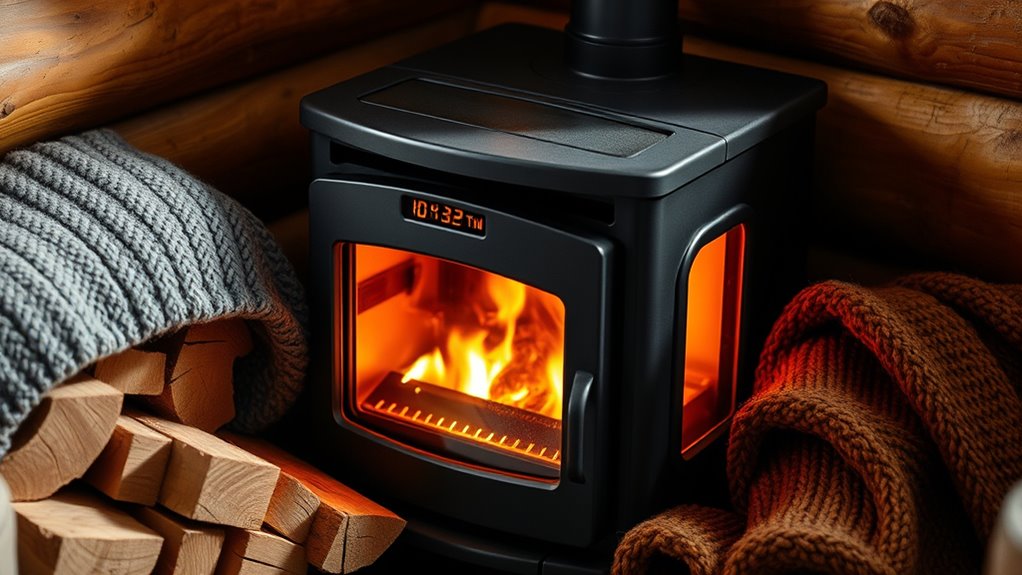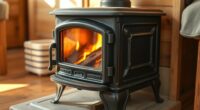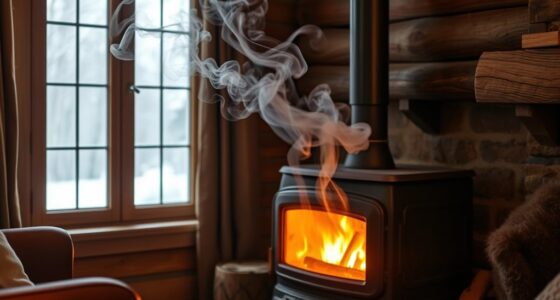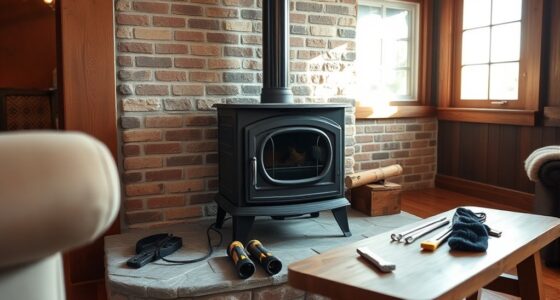To heat a small room effectively, your wood stove should produce around 20 BTUs per square foot if your space is well-insulated. For example, a 200-square-foot room would need about 4,000 BTUs. If your insulation is poor, drafts, or ceilings are high, you may need more—up to 25-30 BTUs per square foot. Understanding your space’s specifics guarantees you choose the right stove capacity for safe, efficient warmth. Keep exploring to learn how to get the best fit for your home.
Key Takeaways
- Most well-insulated small rooms need about 20 BTUs per square foot.
- For example, a 200 sq ft space typically requires around 4,000 BTUs.
- Poor insulation or drafts increase the necessary BTU output.
- Overly large stoves can cause overheating and inefficiency.
- Consider climate, insulation, and room size to determine appropriate BTU range.

Are you wondering how many BTUs a small wood stove needs to effectively heat your space? The answer depends on several factors, but one of the most important is understanding the insulation needs and room size. Properly evaluating these elements ensures you select a stove that provides enough heat without wasting energy or creating safety concerns. If your home or room has poor insulation, you’ll need a stove with a higher BTU output to compensate for heat loss. Conversely, a well-insulated space requires a lower BTU rating to stay warm efficiently.
Proper insulation and room size determine the BTU needed for efficient small wood stove heating.
To determine the right BTU level, start by examining your room size. Measure the total square footage of the area you want to heat. As a general rule, most small rooms need about 20 BTUs per square foot if they are well-insulated. For example, a 200-square-foot room would typically require a stove with around 4,000 BTUs. However, if your space has poor insulation, drafty windows, or high ceilings, you’ll want to increase that number to account for additional heat loss. In such cases, aiming for 25 to 30 BTUs per square foot might be more appropriate.
While room size provides a straightforward starting point, insulation needs greatly influence your final decision. If your walls, ceiling, or floors aren’t well insulated, heat will escape more quickly, meaning a higher BTU stove is necessary. Conversely, a space with high-quality insulation, double-glazed windows, and minimal drafts retains heat better, so a smaller stove with lower BTUs can do the job efficiently. It’s also important to consider other factors like the climate in your area, as colder regions demand more heating capacity, and the presence of other heat sources can reduce the needed BTUs for your wood stove.
Additionally, think about your comfort preferences and how long you want the stove to operate between refueling. A stove with a slightly higher BTU output can provide quicker, more consistent warmth, which might be preferable if you want instant heat. On the other hand, choosing a stove with just enough BTUs ensures you’re not overheating the space or wasting wood energy. Remember, an undersized stove won’t keep your space warm enough, especially during cold snaps, while an oversized one might cause overheating and inefficient fuel use. Properly selecting the correct wood stove BTUs ensures optimal efficiency and comfort.
Frequently Asked Questions
Can a Small Wood Stove Heat an Entire House?
A small wood stove can heat an entire house if you consider proper wood stove placement and chimney size. Position the stove centrally to distribute heat evenly, and make certain your chimney is appropriately sized for efficient draft. While it might not heat large open spaces alone, combined with good insulation and strategic placement, a small stove can effectively warm your whole home. Proper installation maximizes its heating potential.
How Do Outdoor Temperatures Affect BTU Requirements?
Outdoor temperatures directly dictate your BTU needs, demanding more warmth in colder climates and less in milder weather. When outdoor climate cools, insulation efficiency becomes essential, helping retain heat and reduce BTU requirements. Conversely, warmer weather lessens the need for high BTU output. You should adjust your stove size accordingly, ensuring it provides just enough heat without wasting energy, especially as outdoor temperatures fluctuate.
Are Higher BTU Ratings Always Better?
Higher BTU ratings aren’t always better because they don’t guarantee greater efficiency or suitable heating capacity for your space. A stove with a high BTU might produce more heat than needed, wasting energy and increasing costs. Instead, look for a stove with ideal BTU efficiency that matches your heating requirements. This ensures you get enough warmth without overloading your space, saving energy and maintaining comfort.
What Safety Features Should I Look For?
You should look for safety features like automatic shut-off mechanisms and heat shields to prevent accidents. Make certain the stove has effective venting considerations to avoid dangerous smoke or carbon monoxide buildup. Check for secure door latches and proper clearance guidelines. These safety mechanisms protect you and your home, while good venting considerations ensure safe operation and efficient heating. Always prioritize these features when selecting a small wood stove.
How Does Insulation Impact BTU Needs?
Insulation impacts your BTU needs by improving insulation efficiency and heat retention. When your space is well-insulated, less heat escapes, so your stove doesn’t need to produce as many BTUs to keep the area warm. Conversely, poor insulation means you’ll require a higher BTU output to compensate for heat loss. Proper insulation helps you use a smaller stove more effectively, saving energy and enhancing comfort.
Conclusion
In summary, choosing a small wood stove that produces between 4,000 and 12,000 BTUs should keep your space cozy without overheating. Did you know that a typical small home might require around 30,000 BTUs overall? So, selecting the right stove size is vital for efficient heating. By understanding your space’s needs, you’ll enjoy warmth and comfort while saving energy and costs. Make sure to match your stove’s BTUs to your room for the best results!











